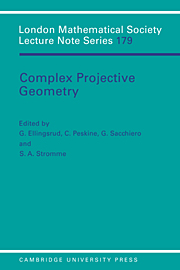Book contents
- Frontmatter
- Contents
- INTRODUCTION
- PROJECTIVE VARIETIES
- VECTOR BUNDLES AND SPECIAL PROJECTIVE EMBEDDINGS
- LIST OF PARTICIPANTS
- Speciality one rational surfaces in P4
- Bounding sections of bundles on curves
- The smooth surfaces of degree 9 in P4
- Compactifying the space of elliptic quartic curves
- Threefolds of degree 11 in P5
- Complete extensions and their map to moduli space
- On the Betti numbers of the moduli space of stable bundles of rank two on a curve
- Gaussian maps for certain families of canonical curves
- Geometry of the Horrocks bundle on P3
- Stability and restrictions of Picard bundles, with an application to the normal bundles of elliptic curves
- Sections planes et majoration du genre des courbes gauches
- A tribute to Corrado Segre
- Un aperçu des travaux mathématiques de G.H. Halphen (1844–1889)
- The source double-point cycle of a finite map of codimension one
- Fibré déterminant et courbes de saut sur les surfaces algébriques
- Courbes minimales dans les classes de biliaison
- Fano 3-folds
- Polarized K3 surfaces of genus 18 and 20
- Protective compactifications of complex afflne varieties
- On generalized Laudal's lemma
- Sur la stabilité des sous-variétés lagrangiennes des variétés symplectiques holomorphes
- Introduction to Gaussian maps on an algebraic curve
- Some examples of obstructed curves in P3
Stability and restrictions of Picard bundles, with an application to the normal bundles of elliptic curves
Published online by Cambridge University Press: 06 July 2010
- Frontmatter
- Contents
- INTRODUCTION
- PROJECTIVE VARIETIES
- VECTOR BUNDLES AND SPECIAL PROJECTIVE EMBEDDINGS
- LIST OF PARTICIPANTS
- Speciality one rational surfaces in P4
- Bounding sections of bundles on curves
- The smooth surfaces of degree 9 in P4
- Compactifying the space of elliptic quartic curves
- Threefolds of degree 11 in P5
- Complete extensions and their map to moduli space
- On the Betti numbers of the moduli space of stable bundles of rank two on a curve
- Gaussian maps for certain families of canonical curves
- Geometry of the Horrocks bundle on P3
- Stability and restrictions of Picard bundles, with an application to the normal bundles of elliptic curves
- Sections planes et majoration du genre des courbes gauches
- A tribute to Corrado Segre
- Un aperçu des travaux mathématiques de G.H. Halphen (1844–1889)
- The source double-point cycle of a finite map of codimension one
- Fibré déterminant et courbes de saut sur les surfaces algébriques
- Courbes minimales dans les classes de biliaison
- Fano 3-folds
- Polarized K3 surfaces of genus 18 and 20
- Protective compactifications of complex afflne varieties
- On generalized Laudal's lemma
- Sur la stabilité des sous-variétés lagrangiennes des variétés symplectiques holomorphes
- Introduction to Gaussian maps on an algebraic curve
- Some examples of obstructed curves in P3
Summary
Introduction.
Let C be a smooth irreducible projective curve of genus g≥1, and for each integer d let Jd(C) be the Jacobian of C, which we view as parametrizing all line bundles on C of degree d. Denote by Lt the bundle on C corresponding to the point t∈Jd(C). Provided that d≥2g-1, the vector spaces H0(C, Lt) fit together to form the fibres of a vector bundle Pd on Jd(C), of rank d+1-g, called the degree d Picard bundle (defined by this description up tp tensoring by line bundles on Jd(C)). These bundles have been the focus of considerable study in recent years, notably by Kempf and Mukai ([K1], [K2], [K3], [M]). To better understand their geometry, it is natural to ask whether Pd is stable with respect to the canonical principal polarization of Jd(C). Kempf [Kl] shows that this is indeed the case for the first bundle P2g-1. The main purpose of this note is to complete Kempf's result by proving the following
Theorem.For every d≥2g, the Picard bundle Pdis stable with respect to the polarization on Jd(C) defined by the theta divisor ΘC⊂Jd(C).
For g = 2, this was established by Umemura [U]. As in [K1], the proof depends on analyzing the restriction of Pd to C. We show that the restriction of Pd to both CC Jd(C) and (−C)⊂Jd(C) are stable; either of these statements implies the result. In the hope that the techniques involved may find other uses in the future, we give rather different arguments for the stability of each of these restrictions.
- Type
- Chapter
- Information
- Complex Projective GeometrySelected Papers, pp. 149 - 156Publisher: Cambridge University PressPrint publication year: 1992
- 42
- Cited by

